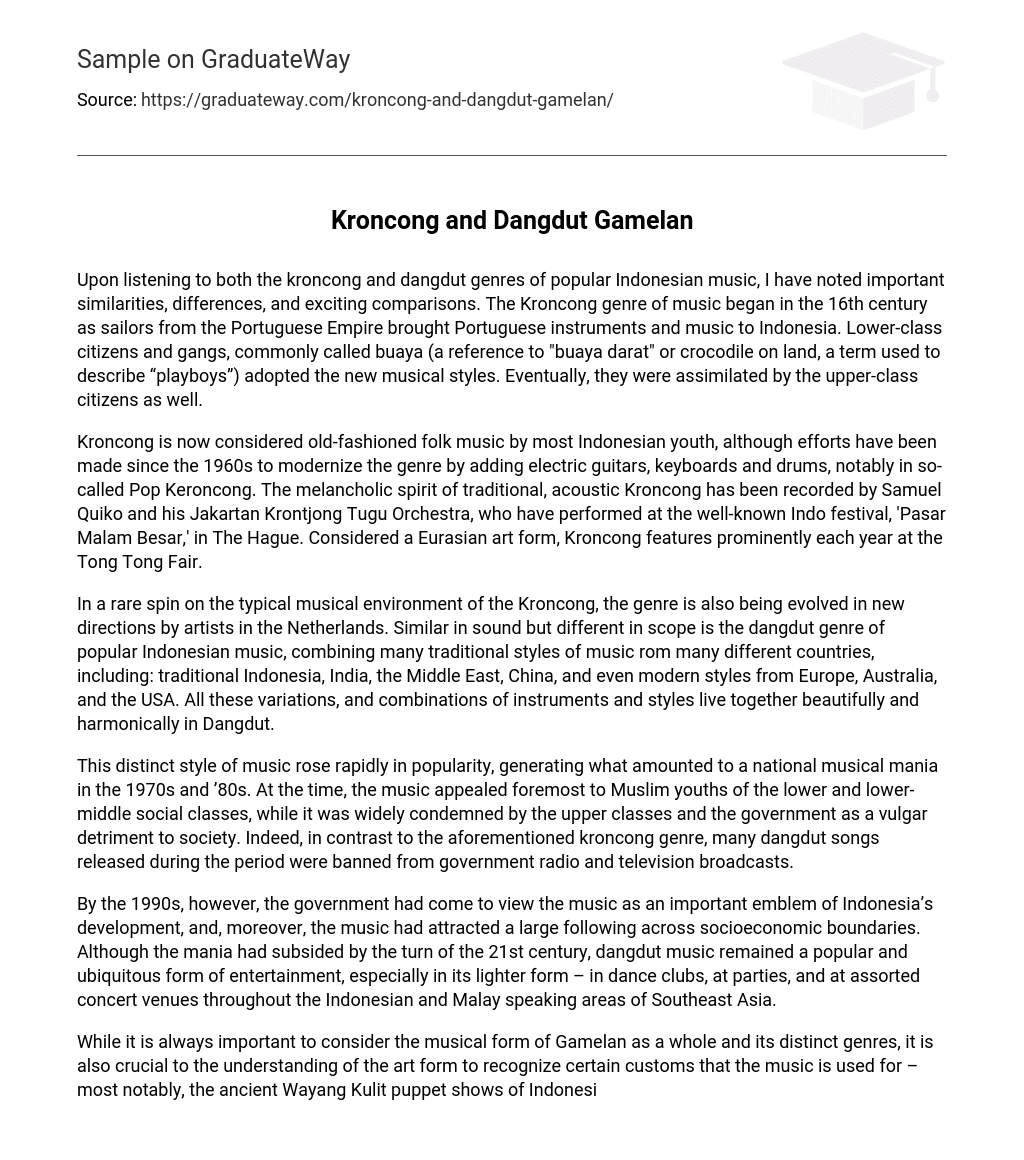Upon listening to both the kroncong and dangdut genres of popular Indonesian music, I have noted important similarities, differences, and exciting comparisons. The Kroncong genre of music began in the 16th century as sailors from the Portuguese Empire brought Portuguese instruments and music to Indonesia. Lower-class citizens and gangs, commonly called buaya (a reference to “buaya darat” or crocodile on land, a term used to describe “playboys”) adopted the new musical styles. Eventually, they were assimilated by the upper-class citizens as well.
Kroncong is now considered old-fashioned folk music by most Indonesian youth, although efforts have been made since the 1960s to modernize the genre by adding electric guitars, keyboards and drums, notably in so-called Pop Keroncong. The melancholic spirit of traditional, acoustic Kroncong has been recorded by Samuel Quiko and his Jakartan Krontjong Tugu Orchestra, who have performed at the well-known Indo festival, ‘Pasar Malam Besar,’ in The Hague. Considered a Eurasian art form, Kroncong features prominently each year at the Tong Tong Fair.
In a rare spin on the typical musical environment of the Kroncong, the genre is also being evolved in new directions by artists in the Netherlands. Similar in sound but different in scope is the dangdut genre of popular Indonesian music, combining many traditional styles of music rom many different countries, including: traditional Indonesia, India, the Middle East, China, and even modern styles from Europe, Australia, and the USA. All these variations, and combinations of instruments and styles live together beautifully and harmonically in Dangdut.
This distinct style of music rose rapidly in popularity, generating what amounted to a national musical mania in the 1970s and ’80s. At the time, the music appealed foremost to Muslim youths of the lower and lower-middle social classes, while it was widely condemned by the upper classes and the government as a vulgar detriment to society. Indeed, in contrast to the aforementioned kroncong genre, many dangdut songs released during the period were banned from government radio and television broadcasts.
By the 1990s, however, the government had come to view the music as an important emblem of Indonesia’s development, and, moreover, the music had attracted a large following across socioeconomic boundaries. Although the mania had subsided by the turn of the 21st century, dangdut music remained a popular and ubiquitous form of entertainment, especially in its lighter form – in dance clubs, at parties, and at assorted concert venues throughout the Indonesian and Malay speaking areas of Southeast Asia.
While it is always important to consider the musical form of Gamelan as a whole and its distinct genres, it is also crucial to the understanding of the art form to recognize certain customs that the music is used for – most notably, the ancient Wayang Kulit puppet shows of Indonesia. Historically, the performance consisted of shadows cast on a cotton screen and an oil lamp. The handwork involved in making a wayang kulit figure that is suitable for a performance takes several weeks, with the artists working together in groups.
They start from master models, which are traced out onto kulit, providing the figures with an outline and with indications of any holes that will need to be cut (such as for the mouth or eyes). The figures are then smoothed, usually with a glass bottle, and primed. The structure is inspected and eventually the details are worked through. A further smoothing follows before individual painting, which is undertaken by yet another craftsman. Finally, the movable parts mounted on the body, which has a central staff by which it is held. A crew makes up to ten figures at a time, typically completing that number over the course of a week.





